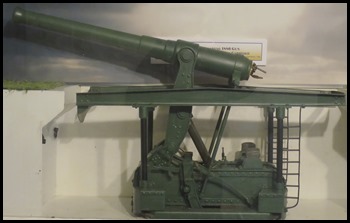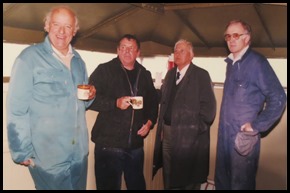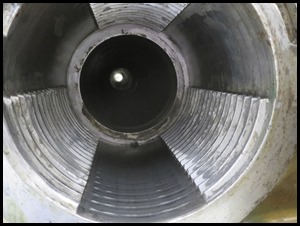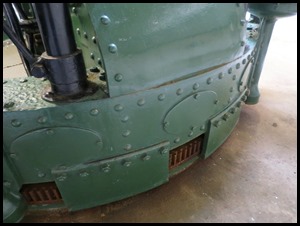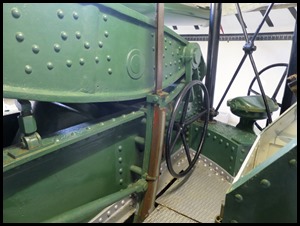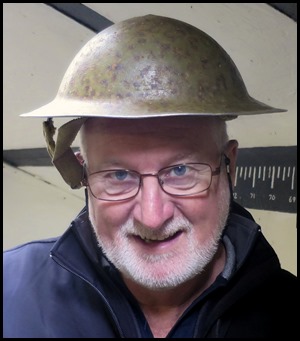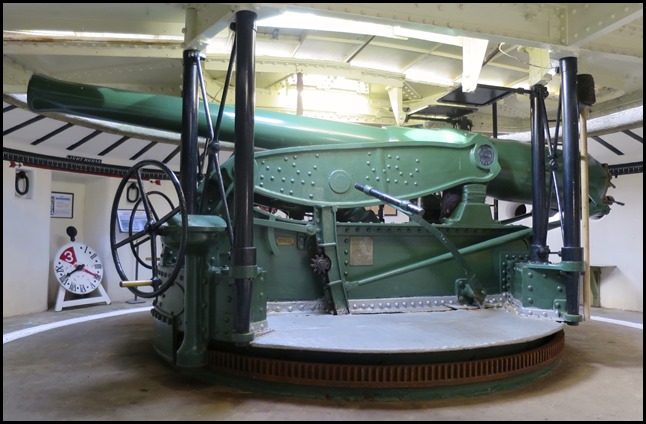Disappearing Gun

|
The Armstrong Disappearing
Gun
  The part of our day that we both
wanted – other than meeting the albatross chicks, was to see the Disappearing
Gun, through corridors under Taiaroa Head and there
she was. Bear in awe before the green leviathan. This
gun is unique, as in it works just as on the day it was first
fired.
 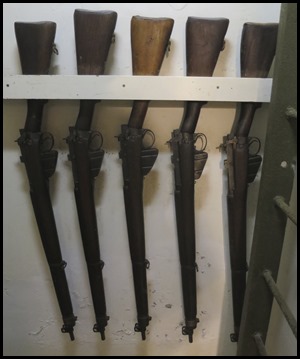 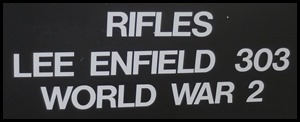 In case of the enemy getting in to the
corridors, racks of Enfields were at the ready. I shot with these in the CCF. No
comment.......
6 Inch Rifled Breech Loading
Hydro-Pneumatic Armstrong Disappearing Gun
Serial Number 4809
Calibre 6 Inches
Projectile 100 Pound
Range 8,800 Yards
Depression 5 Degrees
Elevation 15 Degrees
Length 17 Feet 6 Inches
Rate of Fire 1 Round per
Minute
Manufactured 1886
Weight 18.5 Tons
Detachment 9 Personnel
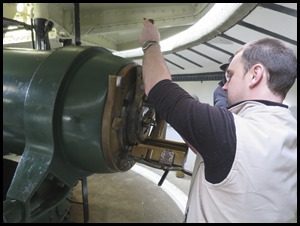 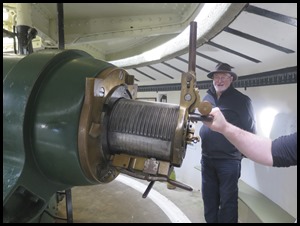  Chris, our guide, easily opens the
‘door’ ready for loading.
Manufactured in Newcastle-upon-Tyne
by W.G. Armstrong & Co. in 1886. The gun was installed and ready for action
at Taiaroa Head in 1889. It is a six inch, breech loading gun on a
hydro-pneumatic carriage. Sited in an underground circular pit, the gun was
aimed and loaded while below ground. The retracting carriage used a hand pumped
water and air system to raise the gun into firing position above ground. Once
the gun was fired, it was returned to the pit by the sheer force of the recoil
and ready for reloading. Despite being the latest technology in the 1880’s, the
Armstrong Disappearing Gun was quickly overtaken by more effective armaments and
was virtually obsolete by 1912.
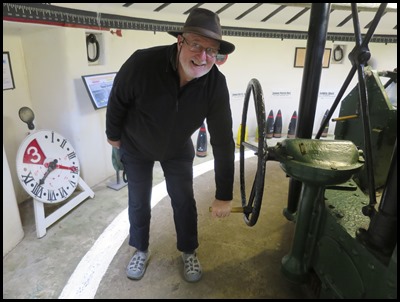  The gun can easily
be swung by one, quickly with one on each of the two wheels. Gun bearing painted on wall.
 It was important for the gun crew to
not aim in the red bit, this was the
lighthouse..........
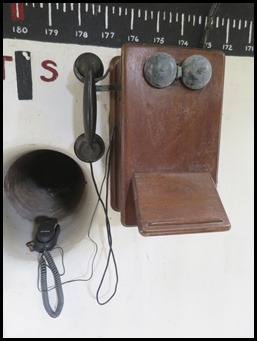  - -The call
would come from the observation room, the team would get ready. Range set by the dial.
Disappearing guns as a functioning concept were invented in the 1860’s by Captain (later Sir) Alexander Moncrieff, who built on his observations in the Crimean War to improve on existing designs for a gun carriage capable of rising over a parapet before being reloaded from behind cover. His key innovation was a counterweight system that raised the gun as well as controlled the recoil. Moncrieff promoted his system as an inexpensive and quickly constructed alternative to a more traditional gun emplacement. Buffington and Crozier further refined the concept in the late 1880’s by incorporating hydro-pneumatic recoil control to assist the counterweight action. The Buffington–Crozier Disappearing Carriage (1893) represented the zenith of disappearing gun carriages, and guns of up to 16-inch size were eventually mounted on such carriages. Disappearing guns were highly popular for a while in the British Empire, the United States and other countries. However, in the 1890’s, a series of Royal Navy/New Zealand Division of the Royal Navy trials carried out in New Zealand (where numerous disappearing guns had been bought and installed during the Russian Scares), revealed the virtual impossibility of a small shore installation being hit by a warship, except by chance. Others dispute that the advantages were so limited, and point to the efficiency of such artillery in for example, the Battle of Port Arthur. In any case, with their protective benefits thus cast into doubt, no further production of the expensive gun carriages was undertaken in New Zealand. Though effective against ships, the guns turned out to be vulnerable to aerial attack. After World War I batteries of disappearing guns were usually casemated for protection or covered with camouflage for concealment. By 1912, the guns were declared obsolete in the British Army, with only some other countries, particularly the United States, still producing them up to World War I and keeping them active through to the end of World War II.
The disappearing carriage had several principal advantages: · It afforded the gun crew protection from direct fire by raising the gun over the parapet (or wall in front of the gun) only when it was to be fired, otherwise leaving it at a lower level, where it was also able to be loaded easily. · With its guns in a retracted position (down behind the parapet), the battery was much harder to spot from the sea, making it a much harder target for attacking ships. Flat trajectory fire tended simply to fly over the battery, without damaging it. · Interposing of a moving fulcrum between the gun and its platform lessened the strain on the latter and allowed it to be of lighter construction while limiting recoil travel. · Simple, well protected earthen and masonry gun pits were much more economical to construct than the previous practice of constructing the standing heavy walls and fortified casemates of a more traditional gun emplacement. · The entire battery could be hidden from view when not in use, unlike a traditional fort, enabling ambuscade fire – that is, to attack from a covert or lurking place.
The disappearing gun had several drawbacks as well: · Some British carriage designs restricted maximum elevation to under twenty degrees and thus lacked the necessary range to match newer naval guns entering service during the early part of the 20th century. (Buffington-Crozier carriages, at their final development, could manage thirty degrees on a sixteen inch gun.) The additional elevation gained by mounting the same gun on a later non-disappearing carriage increased their range. · The time taken for the gun to swing up and down and be reloaded slowed the rate of fire of some designs. Surviving records indicate a rate of fire of one round per one to two minutes for a British 8-inch gun, significantly slower than less complicated guns. (By contrast, the Buffington-Crozier 16' inch mount could manage one round per minute; the barbette mount was only 20% faster, and was slower at some elevations.) · The improvement in the speed of warships demanded an increased rate of firing. The disappearing gun was at a disadvantage compared with a gun that stayed in position as one could not aim or reposition a disappearing gun while it was in the lowered position. The gunner still had to climb atop the weapon via an elevated platform to sight and lay the weapon after it was returned to firing position, or receive fire control information (range and bearing) transmitted from a remote location. · Their relative size and complexity also made them expensive compared with non-disappearing mounts, (but this was more than made up, for some designs, by the reduced cost of protection).
Some of the restoration Team. Gun experts. Left to right - Dick Skinner, Colin Young and Jack Joyce. Fitting the breech.
Beautiful engineering and tooling.
Don’t tell them your name, Pike.
The only one in the world able to function – as good as new.
ALL IN ALL WHAT A PIECE OF KIT INCREDIBLE ENGINEERING BEAUTIFULLY RESTORED |

